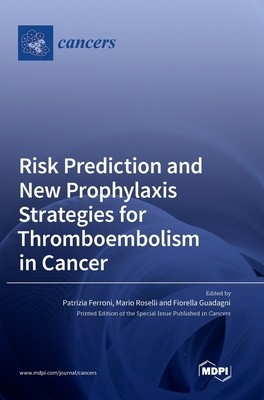
- We will send in 10–14 business days.
- Publisher: MDPI AG
- ISBN-10: 303654707X
- ISBN-13: 9783036547077
- Format: 17 x 24.4 x 1.8 cm, hardcover
- Language: English
- SAVE -10% with code: EXTRA
Risk Prediction and New Prophylaxis Strategies for Thromboembolism in Cancer (e-book) (used book) | bookbook.eu
Reviews
Description
Thromboembolism is a compelling challenge in cancer care because of its life-threatening nature as well as its impact on specific treatments. Current guidelines do not generally recommend antithrombotic prophylaxis, except in selected categories of patients at high risk of thrombosis. Accordingly, several clinical decision models have been developed to guide the oncologist in thromboembolic risk assessment and targeted prophylaxis. Low-molecular-weight heparins (LMWH) are currently considered as the standard approach in clinical practice guidelines, but recent randomized controlled trials (RCT) indicate that direct oral anticoagulants (DOACs) are effective for the treatment/prophylaxis of cancer-associated thromboembolism. However, many unanswered questions remain on the efficacy and safety of anticoagulants in selected cancer subgroups, and in primary and secondary prevention settings, where anticoagulation needs to be balanced on the risk of bleeding complications. Presently, patient selection remains the main challenge. Improvement in existing VTE risk models or the construction of alternative risk assessment tools are needed in order to ameliorate the risk stratification of cancer patients. This reprint will cover the current clinical evidence supporting the standard of care and emerging treatment/prophylactic options for cancer-associated thromboembolism during both active treatment and simultaneous/palliative care. Tailored approaches based on the use of individualized factors to stratify the thrombotic/bleeding risk in each individual patient are discussed.
EXTRA 10 % discount with code: EXTRA
The promotion ends in 5d.00:51:24
The discount code is valid when purchasing from 10 €. Discounts do not stack.
- Publisher: MDPI AG
- ISBN-10: 303654707X
- ISBN-13: 9783036547077
- Format: 17 x 24.4 x 1.8 cm, hardcover
- Language: English English
Thromboembolism is a compelling challenge in cancer care because of its life-threatening nature as well as its impact on specific treatments. Current guidelines do not generally recommend antithrombotic prophylaxis, except in selected categories of patients at high risk of thrombosis. Accordingly, several clinical decision models have been developed to guide the oncologist in thromboembolic risk assessment and targeted prophylaxis. Low-molecular-weight heparins (LMWH) are currently considered as the standard approach in clinical practice guidelines, but recent randomized controlled trials (RCT) indicate that direct oral anticoagulants (DOACs) are effective for the treatment/prophylaxis of cancer-associated thromboembolism. However, many unanswered questions remain on the efficacy and safety of anticoagulants in selected cancer subgroups, and in primary and secondary prevention settings, where anticoagulation needs to be balanced on the risk of bleeding complications. Presently, patient selection remains the main challenge. Improvement in existing VTE risk models or the construction of alternative risk assessment tools are needed in order to ameliorate the risk stratification of cancer patients. This reprint will cover the current clinical evidence supporting the standard of care and emerging treatment/prophylactic options for cancer-associated thromboembolism during both active treatment and simultaneous/palliative care. Tailored approaches based on the use of individualized factors to stratify the thrombotic/bleeding risk in each individual patient are discussed.


Reviews